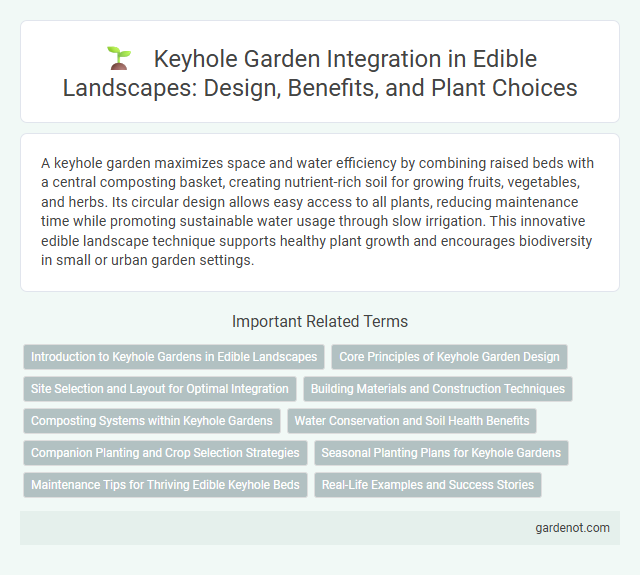A keyhole garden maximizes space and water efficiency by combining raised beds with a central composting basket, creating nutrient-rich soil for growing fruits, vegetables, and herbs. Its circular design allows easy access to all plants, reducing maintenance time while promoting sustainable water usage through slow irrigation. This innovative edible landscape technique supports healthy plant growth and encourages biodiversity in small or urban garden settings.
Introduction to Keyhole Gardens in Edible Landscapes
Keyhole gardens are circular raised beds designed with a central compost basket, optimizing water retention and nutrient recycling in edible landscapes. This gardening method enhances soil fertility and supports diverse plant growth by creating a microclimate ideal for vegetables, herbs, and fruits. Popular in arid regions, keyhole gardens maximize space efficiency and promote sustainable food production.
Core Principles of Keyhole Garden Design
Keyhole garden design maximizes space efficiency by integrating a circular raised bed with a central composting basket that nourishes plants through nutrient recycling. Its core principles include water conservation via a well-drained but moisture-retentive soil mix, strategic layering of organic matter for continuous soil fertility, and ergonomic accessibility achieved through a keyhole-shaped notch allowing easy reach. This sustainable design promotes biodiversity, enhances soil health, and reduces waste, making it an ideal model for edible landscapes.
Site Selection and Layout for Optimal Integration
Choosing a site with ample sunlight and well-drained soil is crucial for the success of a keyhole garden, ensuring optimal growth of edible plants. The layout should incorporate a circular design with a central composting basket to facilitate efficient nutrient recycling and water conservation. Positioning the garden near kitchen access points maximizes convenience and encourages regular harvesting.
Building Materials and Construction Techniques
Keyhole gardens utilize locally sourced, sustainable materials such as stone, brick, or recycled wood to build a circular raised bed with a central composting basket, optimizing nutrient flow and water retention. Construction techniques focus on layering soil, organic matter, and compost within the bed, ensuring efficient drainage and aeration while minimizing water usage in dry climates. The compact design and sturdy materials facilitate easy access for planting and harvesting, promoting soil health and maximizing productivity in small edible landscapes.
Composting Systems within Keyhole Gardens
Keyhole gardens incorporate efficient composting systems by positioning a central compost basket that feeds nutrient-rich liquid directly to surrounding plants. This design maximizes decomposition of organic waste, enhancing soil fertility while conserving water through targeted nutrient recycling. The composting core sustains plant growth by continuously supplying essential micro and macronutrients, creating a self-sustaining edible landscape system.
Water Conservation and Soil Health Benefits
Keyhole gardens maximize water conservation through efficient irrigation methods such as mulching and drip systems, reducing evaporation and water runoff. The design promotes soil health by incorporating organic matter and compost in the central composting basket, enriching the soil with nutrients and improving microbial activity. This sustainable gardening approach supports robust plant growth while preserving soil moisture and fertility.
Companion Planting and Crop Selection Strategies
Keyhole gardens utilize companion planting and strategic crop selection to maximize space and enhance soil fertility, promoting sustainable edible landscapes. By pairing compatible plants such as legumes for nitrogen fixation with nutrient-demanding crops like tomatoes, the garden optimizes nutrient cycling and pest control. Selecting diverse crops based on growth habits and root depths ensures efficient resource use and improves overall yield in compact raised beds.
Seasonal Planting Plans for Keyhole Gardens
Seasonal planting plans for keyhole gardens optimize space and yield by selecting crops suited to each season's climate and daylight hours. Cool-season vegetables like lettuce, spinach, and radishes thrive in spring and fall, while warm-season crops such as tomatoes, peppers, and beans flourish in summer. Rotating crops according to seasonal conditions maintains soil health and ensures continuous harvests throughout the year in the keyhole garden's compact space.
Maintenance Tips for Thriving Edible Keyhole Beds
Keyhole gardens require consistent moisture retention through mulching and regular watering to ensure nutrient-rich soil supports plant growth. Incorporating compost and organic matter replenishes essential nutrients, promoting healthy root systems and vibrant edible yields. Regular weeding and monitoring for pests prevent competition and damage, maintaining a thriving keyhole bed ecosystem.
Real-Life Examples and Success Stories
Keyhole gardens have transformed urban agriculture by maximizing space and water efficiency, as demonstrated in South African communities where they provide consistent food sources amid drought conditions. In Rwanda, households report 70% increased yield using composting and water-conserving designs inherent to keyhole gardens, enhancing nutrition and economic resilience. Innovative projects in Australia showcase how keyhole gardens support sustainable eating by integrating native plants and reducing reliance on commercial produce.
Keyhole garden Infographic

 gardenot.com
gardenot.com